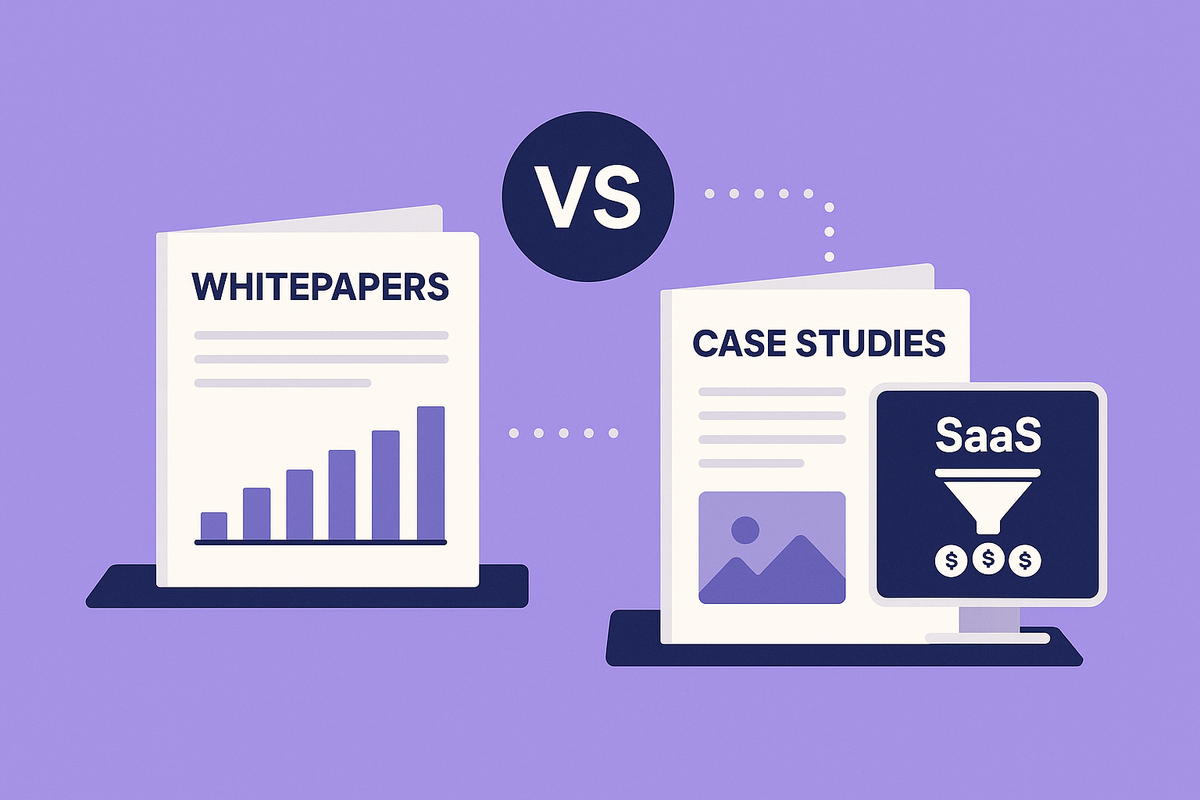Introduction: Navigating Content Fatigue in B2B SaaS
In 2025, SaaS marketers face an increasingly discerning audience. Buyers are saturated with content, yet they're hungry for resources that add real value. While content marketing remains a pillar of B2B lead generation, the effectiveness of various formats is under constant scrutiny. Among the most debated choices: whitepapers vs. case studies. Which one better drives pipeline growth, captures qualified leads, and builds trust in high-consideration tech purchases?
This blog unpacks that debate with a fresh 2025 lens. Whether you're optimizing a demand generation campaign or revamping your content calendar, understanding the strengths, limitations, and ideal use cases of these two formats is essential for maximizing ROI.
Section 1: What Are Whitepapers and Case Studies in 2025?
Whitepapers are in-depth, research-backed documents that explore industry problems, trends, or solutions with a focus on education and authority. In 2025, whitepapers have evolved beyond static PDFs. They often include embedded video, interactive charts, and personalization features. Still, the core objective remains: to offer thought leadership and generate mid-to-high intent leads by addressing strategic pain points.
Case studies, by contrast, are real-world stories that showcase how a customer successfully implemented a product or service. The best case studies highlight business context, measurable outcomes, and proof of ROI. In 2025, dynamic case studies often feature customer interviews, performance dashboards, and even customer-led storytelling.
Both formats play a role in content-driven lead gen, but their impact varies depending on campaign goals, buyer journey stage, and audience expectations.
Section 2: Pros and Cons for Lead Generation
Whitepapers
Pros:
- Establish authority and domain leadership
- Ideal for complex buying committees and technical stakeholders
- Generate leads with higher consideration intent
- Support long-tail SEO and thought leadership strategies
Cons:
- Require significant resources to produce (research, design, review)
- May suffer from low engagement if the topic isn’t timely or actionable
- Often gated, which can deter early-stage prospects
Case Studies
Pros:
- Provide social proof and real-world application
- Easier and quicker to digest
- Strong assets for bottom-of-funnel (BOFU) engagement
- Boost trust with decision-makers who need validation
Cons:
- Harder to scale; require customer cooperation
- Typically appeal to buyers who are already problem-aware
- May lack broader industry insights
Both formats have distinct roles, but neither is a silver bullet. The key is alignment with where your buyer is in their decision-making process.
Section 3: Funnel Fit — When to Use What
The success of whitepapers and case studies hinges on context. Here's how they map to the buyer journey:
Top of Funnel (TOFU):
- Whitepapers: Use to introduce macro trends, educate new audiences, and generate awareness. For example, a whitepaper on "2025 Trends in Cloud Security for SaaS Startups" can attract attention from a broad segment.
- Case Studies: Rarely used at TOFU unless the use case addresses a highly relatable, urgent problem.
Middle of Funnel (MOFU):
- Whitepapers: Shine here. Ideal for targeting leads who've expressed interest and want to explore solution options. Topics like "How Zero Trust Architecture Enhances SaaS Compliance" educate and nudge consideration.
- Case Studies: Can validate the effectiveness of broader solution categories, especially if segmented by vertical or company size.
Bottom of Funnel (BOFU):
- Case Studies: Essential at this stage. When buyers are evaluating vendors, real-world success stories become powerful proof points.
- Whitepapers: Less relevant unless they include implementation guides or ROI modeling.
Understanding how these formats support movement through the funnel is crucial for campaign planning.
Section 4: Performance Insights — Lead Quality, Conversion, and Buyer Behavior
Recent findings from toolsmetric.com show that B2B buyers now spend 30% more time evaluating third-party content than brand-owned assets. In syndication programs, whitepapers tend to attract mid-funnel leads who are research-driven and strategic. These leads are more likely to convert if nurtured correctly.
On the other hand, case studies excel at increasing win rates. Sales teams report up to a 28% boost in close rates when customized case studies are included in proposals.
Lead scoring models often assign higher scores to whitepaper downloads due to the perceived effort and intent required to consume them. However, case studies have higher re-engagement rates when shared via email or used in account-based marketing (ABM) touchpoints.
To maximize ROI, it's essential to use each asset not in isolation, but as part of a cohesive nurture strategy that respects buyer psychology.
Section 5: Building a Hybrid Content Strategy
Rather than picking sides, top-performing SaaS marketers are building hybrid content ecosystems that combine the strengths of both formats. Here are some winning tactics:
- Bundle Strategically: Pair a whitepaper with two industry-specific case studies to cater to both rational and emotional decision drivers.
- Progressive Gating: Offer the case study ungated but require form-fill for the whitepaper. This creates value perception and encourages deeper engagement.
- Repurpose Smartly: Turn key whitepaper insights into snackable blog posts, infographics, or sales enablement decks. Feature related case studies at the end for contextual proof.
- Use in Account-Based Campaigns: Personalize case studies by vertical or region and pair them with gated whitepapers for high-value accounts.
By combining educational depth with emotional validation, SaaS marketers can significantly improve lead velocity and deal quality.
Conclusion: Context Is King in 2025
In the battle of whitepapers vs. case studies, there’s no universal winner—only strategic use cases. Whitepapers are unmatched for mid-funnel education and positioning. Case studies, meanwhile, excel in the final decision stage by providing credibility and clarity.
A smart lead generation engine doesn’t choose between formats; it orchestrates them. By mapping each content piece to a specific stage of the buyer journey and using performance insights to iterate, SaaS marketers can reduce cost-per-lead, accelerate pipeline movement, and improve close rates.
With modern content fatigue on the rise, differentiation lies in delivering the right message to the right persona at the right time. And often, that means pairing your bold whitepaper with a compelling case study.

